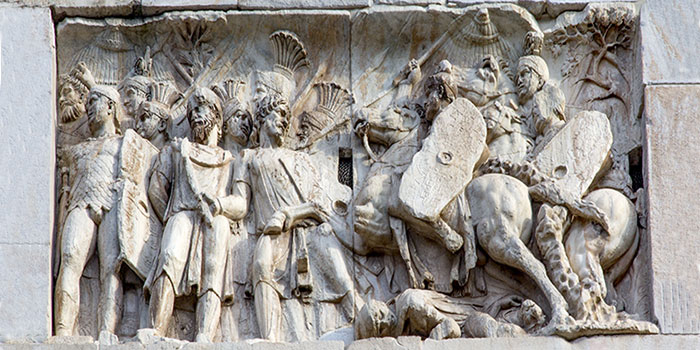
CoinWeek Ancient Coin Series by Mike Markowitz …..
ANCIENT GREEK ARMIES fought mainly with the spear. Roman legions fought mostly with the sword. Persians fought largely with the bow and arrow[1]. The mythical warrior Herakles (or Hercules) wielded a knobby wooden club.
All these weapons, and many others, feature prominently on ancient coins. War was a central preoccupation of most ancient states, and rulers and magistrates who commissioned engravers to create coin designs wanted accurate depictions of their weapons and the weapons carried by their gods, heroes, and foes.
Spear
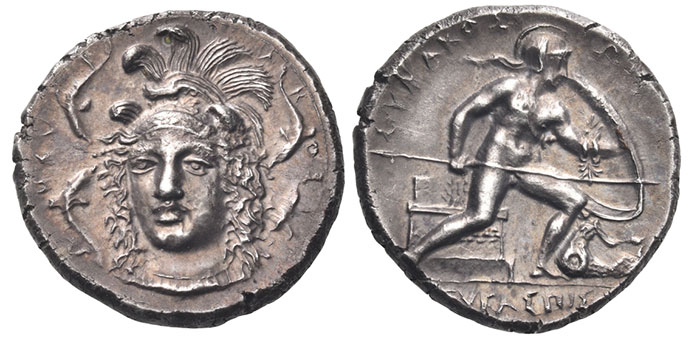
Ancient Greek infantry soldiers are called hoplites, after the hoplon, a deep, dish-shaped shield carried on the left arm. Dense formations of hoplites stood shoulder to shoulder, forming a solid shield wall, projecting a row of spear points. The spear (dory in Greek, hasta in Latin), carried in the right hand, had a wooden shaft about 2.5 meters (8 feet) long, with a leaf-shaped iron point and a bronze spike at the other end. A typical hoplite appears on the reverse of a silver drachma[2] of the Syracusan tyrant Dionysios I (ruled 405 – 367 BCE). This coin is attributed to the master engraver Eukleidas. Note that the soldier is naked except for his helmet, a sensible adaptation to a hot climate. This may also reflect an awareness that garment fibers driven into a wound by a spearpoint promoted infection. The spear could be wielded overhand to strike above the shield, or as shown here, underhand to strike around or below it.
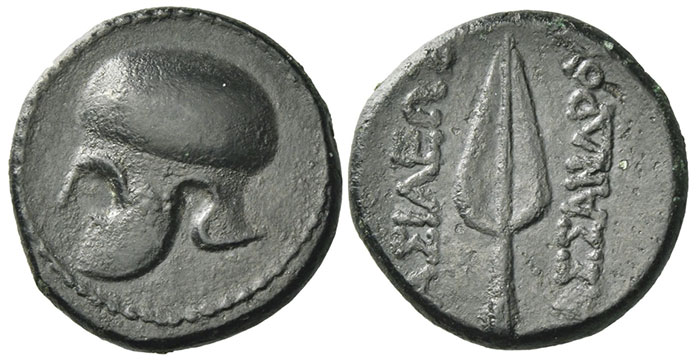
A close-up view of a typical ancient leaf-shaped spear point is found on a small bronze coin of the Macedonian king Kassandros (ruled 317-297 BCE)[3].
Sarissa
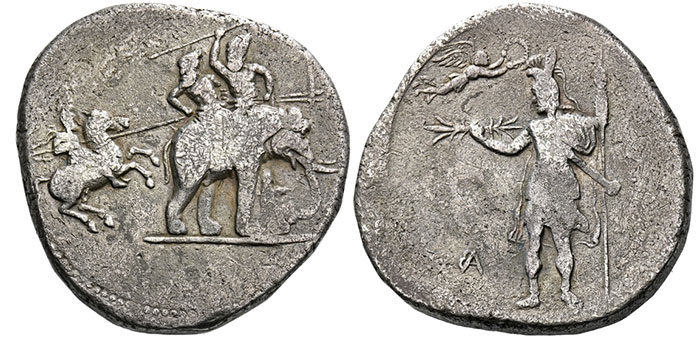
The most famous representation of this weapon on a coin is a very rare silver dekadrachm of Alexander the Great[5], probably issued at Babylon about 327 BCE. On the coin we see Alexander on his horse, Boukephalos, charging an elephant ridden by the Indian king Porus, and an attendant. Alexander seems to be spearing the attendant in the back, while Porus turns to hurl a javelin. The image is pure propaganda: according to ancient sources, this duel never actually took place.
On the reverse, a standing figure of Alexander holds a thunderbolt, the supernatural weapon of Zeus, in his right hand, while the shaft of a sarissa held vertically in his left hand runs right off the edge of the coin.
Only 10 examples of this coin are known, five in museums. On Harlan Berk’s list of the 100 Greatest Ancient Coins, this type is #41 (Berk, 65).
Javelin
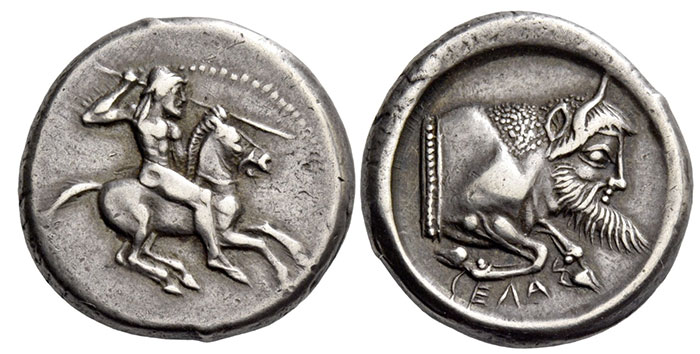
Unlike a spear, which is a thrusting weapon, the javelin is a missile designed for throwing. weighing between 1-3 kg with an effective range of about 15-20 meters[6]. It was thrown by light infantry and cavalry, who went into battle carrying two or three weapons.
Until stirrups came into wide use in the west in the sixth century CE, mounted shock combat was risky (this made Alexander’s performance on the coin above so remarkable):
Before the introduction of the stirrup, the seat of the rider was precarious … Swordplay was limited because without stirrups your slashing horseman, taking a good broadhanded swipe at his foe had only to miss to find himself on the ground. As for the spear,… it was wielded at the end of the arm and the blow was delivered with the strength of the shoulder and biceps… The stirrup … effectively welded horse and rider into a single fighting unit… (White, 1-2).
An ancient mounted javelin fighter appears on a lovely silver didrachm of Gela in Sicily, c. 480 BCE. The naked rider raises his right arm to hurl a slender shaft, while holding the reins in his left hand, out of sight behind the horse’s neck[7].
Chariot
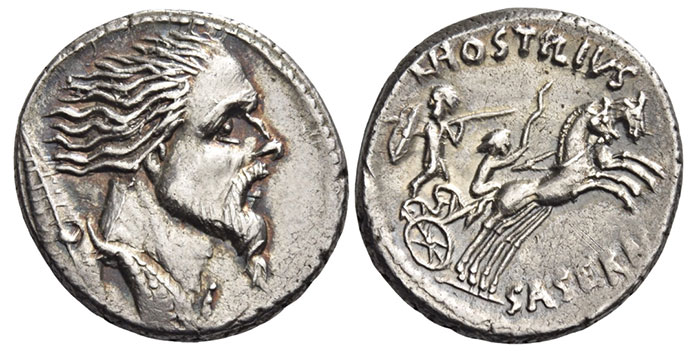
Most of the chariots depicted on ancient coins are vehicles of gods, sport racers, or ceremonial parade floats. By 500 BCE, when pictorial images on coins become common, the chariot was mostly obsolete as a combat platform in the Mediterranean world.
A few coins, however, depict battle chariots in action.
An excellent example is a Roman denarius of 48 BCE issued by the moneyer Lucius Hostilius Saserna, who is otherwise unknown. The obverse bears the head of a Celtic warrior, thought to be Vercingetorix, the tribal chieftain defeated by Julius Caesar in 52 BCE. On the reverse, a two-horse Celtic chariot races left, the driver wielding a whip, while a warrior standing with a shield turns to hurl a javelin[8].
Long Bow
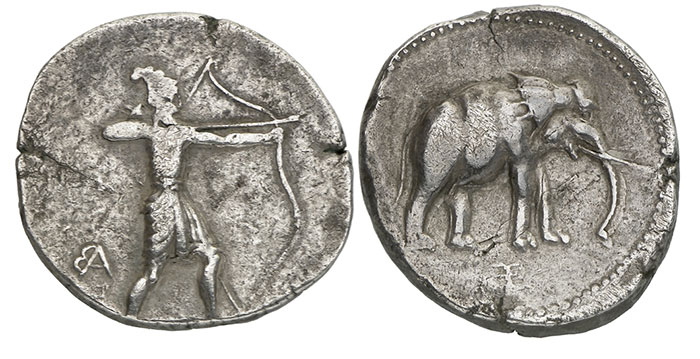
We think of the long bow as a medieval Welsh and English weapon, but a remarkable and very rare silver tetradrachm[9] of Alexander the Great, probably issued at Babylon, c. 327 BCE, confirms a story told centuries later by the Romanized Greek historian Arrian who lived c. 89 – 146 CE:
The infantry have a bow, of the height of the owner; this they poise on the ground, and set their left foot against it, and shoot thus; drawing the bowstring a very long way back; for their arrows are little short of three cubits, and nothing can stand against an arrow shot by an Indian archer, neither shield nor breastplate nor any strong armour[10].
The coin, which bears an Indian elephant on the reverse, shows an Indian archer in exactly the stance Arrian described. In 326 BCE, Alexander himself suffered a nearly fatal chest wound when an Indian arrow pierced his breastplate.
Short Bow
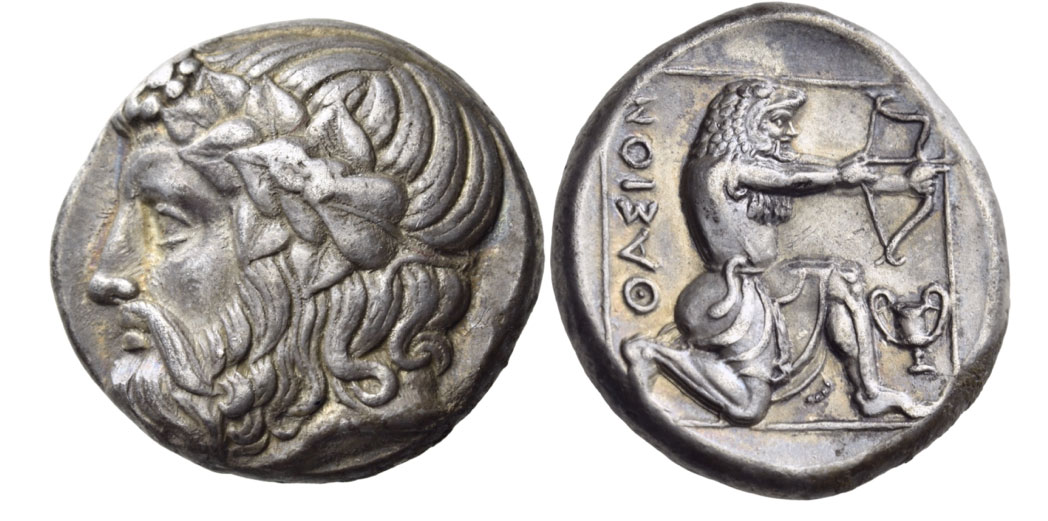
The composite bow[11] originated among the steppe nomads of Central Asia as early as the second millennium BCE. Constructed from strips of horn, wood, and sinew laminated with fish glue, it required strong arms and a lifetime of practice to shoot effectively. The hero Odysseus (or Ulysses) slew the suitors who had taken over his household with arrows fired from a composite bow so stiff that only he could string it:
…as soon as he had lifted the great bow and scanned it on every side—even as when a man well-skilled in the lyre and in song easily stretches the string about a new peg, making fast at either end the twisted sheep-gut—so without effort did Odysseus string the great bow[12].
To Greeks and Romans, the bow was the weapon of Persians, Scythians, and other exotic barbarians. A composite bow in action appears on a rare silver tetradrachm of the island of Thasos, c. 350 BCE[13]. On the reverse, Herakles kneels while drawing his bow.

A magnificent gold aureus[14] of the demented Roman emperor Commodus, who came to believe that he was Herakles reincarnate, provides a detailed depiction of the mythic hero’s bow, quiver of arrows, and club. In the sixth of his Twelve Labors, Herakles used this bow to kill the toxic, armored, man-eating Stymphalian birds.
Sword
For centuries the sword has been not merely a weapon but a powerful symbol and fashion accessory.
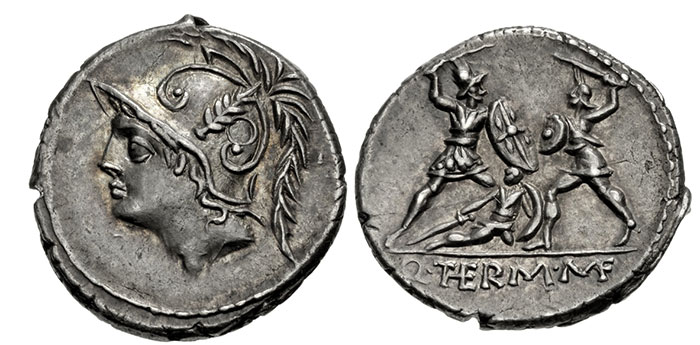
In the Roman Republic, mint officials who chose the coin designs often advertised the heroic military exploits of their ancestors in order to promote their own political careers. A dramatic battle scene on a silver denarius[15] of 103 BCE depicts Quintus Minucius Thermus, consul in 193 BCE, fighting a Ligurian warrior to defend an injured fallen comrade. Both fighters advance, raising their swords to strike, in a neatly symmetrical composition. For saving the life of a citizen in battle, Thermus was awarded the Corona Civica[16] (roughly equivalent to the Medal of Honor or the Victoria Cross).
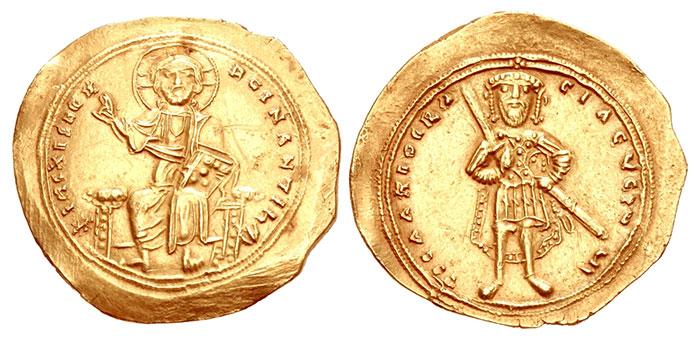
Perhaps the most controversial appearance of a sword on a coin is the gold nomisma[17] of the Byzantine emperor Isaac Komnenos (or “Comnenus“), who reigned briefly at Constantinople from 1057 to 1059. A successful general, Isaac came to the throne by leading a revolt against the unpopular Michael VI. He appears on the coin standing aggressively with a drawn sword, grasping the scabbard with his left hand. “…the … type with a naked sword was wholly new. It was this which particularly caused offense, for it seemed to imply that the emperor believed he owed his throne to his military qualities, not to divine decree (Grierson, 760).”
By this era, the short Roman gladius had been replaced by a longer sword, the spathion, with a tapered double-edged blade up to 95 cm (37 inches) long. No subsequent emperor dared to depict himself on coinage with a drawn sword.
Gladiators
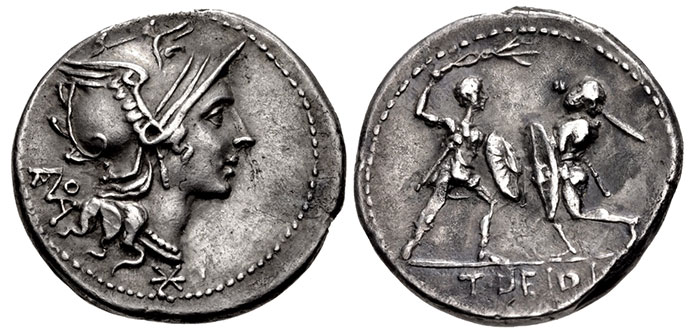
The Hollywood film Gladiator (2000) takes some liberties with history, but it accurately depicts the Roman population’s obsession with staged combat in the arena.
A good example is a Roman denarius[18] of 113-112 BCE issued by a mint official (triumvir monetalis) named Titus Didius[19], who rose to become a victorious general and consul of the Republic. The crowd particularly enjoyed duels between gladiators armed with dissimilar exotic weapons. The fighter on the left wields a weapon described as a “flail”; it appears to be a flagrum, a bundle of cords spiked with metal. The one on the right holds a sword considerably longer than the typical short Roman gladius, which had a blade 50-65 cm (19-25 inches) long.
By placing this image on his coinage, Didius was advertising a promise to stage popular gladiatorial fights if he were elected to higher office.
Trophy of Arms
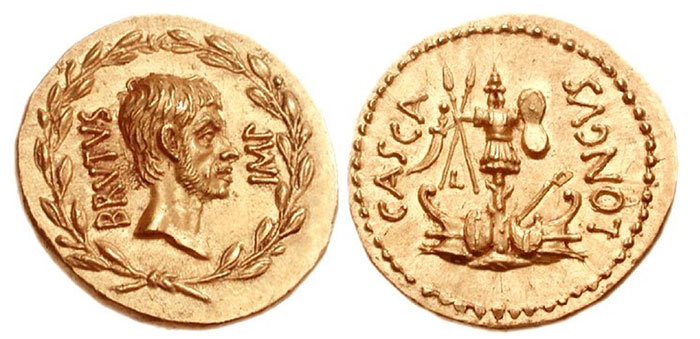
A “Trophy of Arms”[20] is often seen on ancient coins, and it became a popular ornament in classical art and architecture. It originated as a wooden frame set up as a memorial on a battlefield, decorated with captured enemy weapons and armor.
An elaborate example is the reverse of a gold aureus issued for the army of Brutus and Casca Longus in 42 BCE. Casca was the first of the assassins to stab Julius Caesar. The obverse bears a portrait of Brutus within a wreath. The reverse shows a trophy that includes a helmet, a suit of armor, a shield, two crossed spears, and a curved sword, all mounted on the prows of two ships. Just 17 examples are known (eight in museums).
A cataloguer wrote:
The trophy on the reverse combines elements of land and sea victories, and is thought to celebrate the military victories of Brutus in Lycia and Thrace, along with the heroic naval feats of Cassius in resistance to the Rhodians[21].
Defeated at the Battle of Philippi on October 23, 42 BCE, Brutus and Casca killed themselves.
Dagger
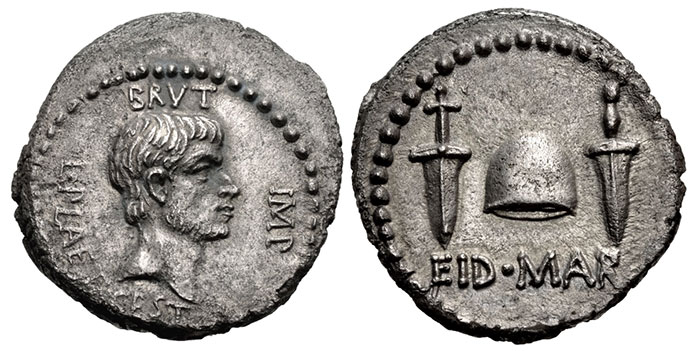
Easily concealed in the fold of a toga, the Roman dagger (pugio in Latin) was the ideal assassin’s weapon. With a steel blade 18-27 cm long (7-11 inches) the pugio, like the Roman sword (gladius) was based on native weapons the Romans had admired in Spain[22].
Two daggers feature prominently on the most famous ancient coin: the EID MAR denarius of Brutus, issued in Greece by a military mint moving with the army of Caesar’s assassins in 42 BCE (Berk, 86). Only about 80 genuine examples of this coin are known. The inscription below the daggers abbreviates the Latin phrase Eidibus Martiae (“on the Ides of March”) a date every Roman would have recognized: March 15, 44 BCE, when Brutus, Cassius, and a group of conservative aristocrats stabbed Julius Caesar to death in the Senate. The gumdrop-shaped object between the daggers is a pileus, the felt cap worn by freed slaves to indicate their status[23]. The brutal symbolic message is “with these daggers, we freed ourselves from the slavery Caesar wanted to impose on us.” In a 2020 New York sale, an example of this type graded “choice, about uncirculated”, sold for $300,000 USD.
* * *
Notes
[1] When he was told that Persian archers fired volleys of arrows so thickly that they blocked out the sun, Spartan king Leonidas famously replied, “Then we shall fight in the shade.”
[2] Nomos Auction 17, October 26, 2018, Lot 52. Realized CHF 11,000 (about $10,985 USD; estimate CHF 5,000).
[3] NAC Auction 123, May 9, 2021, Lot 231. Realized CHF 200 (about $220 USD; estimate CHF 250).
[4] https://en.wikipedia.org/wiki/Sarissa
[5] NAC Auction 124 June 23, 2021, Lot 84. Realized CHF 700,000 (about $760,456 USD; estimate CHF 300,000).
[6] The modern Olympic men’s javelin of solid metal weighs just 800 grams, and is typically thrown to a distance over 90 meters.
[7] NAC Auction 114, May 6, 2019, Lot 40. Realized CHF 12,500 (about $12,283 USD; estimate CHF 2,500).
[8] NAC Auction 120, October 6, 2020, Lot 609. Realized CHF 5,500 (about $6,010 USD; estimate CHF 2,500).
[9] New York Sale XXVII, January 4, 2012. Lot 305. Realized $55,000 (estimate $25,000).
[10] Arrian. Book VIII, Chapter XVI.
[11] https://en.wikipedia.org/wiki/Composite_bow
[12] Odyssey. Book 21, lines 405-410.
[13] Nomos Auction 16,May 10, 2018, Lot 56. Realized CHF 50,000 (about $49,791 USD; estimate CHF 35,000).
[14] NAC Auction 38, March 21, 2007,Lot 89. Realized CHF 300,000 (about $246,873 USD; estimate CHF 50,000).
[15] CNG Electronic Auction 492,May 26, 2021, Lot 324. Realized $900 (estimate $400).
[16] https://en.wikipedia.org/wiki/Civic_Crown
[17] CNG Electronic Auction 492, May 26, 2021, Lot 507. Realized $1,200 (estimate $750).
[18] CNG Auction 112, September 11, 2019, Lot 502. Realized $1,300 (estimate $500).
[19] https://en.wikipedia.org/wiki/Titus_Didius
[20] https://en.wikipedia.org/wiki/Trophy_of_arms
[21] CNG Triton XIX, January 5, 2018, Lot 420. Realized $800,000 (estimate $750,000).
[22] https://en.wikipedia.org/wiki/Pugio
[23] A floppy version of this headgear was adopted as the symbolic “Liberty cap” by 18th-century American and French revolutionaries and appears on many classic American coins.
[24] CNG Triton XXIII, January 20,2020, Lot 620. Realized $300,000 (estimate $200,000).
References
https://sourcebooks.fordham.edu/ancient/arrian-bookviii-india.asp
Berk, Harlan J. 100 Greatest Ancient Coins. Pelham, AL (2019)
Grierson, Philip. Catalogue of the Byzantine Coins in the Dumbarton Oaks Collection, Volume 3, Part 2. Washington (1973)
Hanson, Victor D. (ed.) Hoplites: The Classical Greek Battle Experience. London (1991)
Holt, Frank L. Alexander the Great and the Mystery of the Elephant Medallions. Berkeley (2003)
http://www.perseus.tufts.edu/hopper/text?doc=Perseus%3Atext%3A1999.01.0136%3Abook%3D21
Lendon, J.E. Soldiers and Ghosts: A History of Battle in Classical Antiquity. New Haven (2005)
Meijer, Fik. The Gladiators: History’s Most Deadly Sport. New York (2003)
White, Lynn, Jr. Medieval Technology & Social Change. Oxford (1962)
* * *
 Mike Markowitz is a member of the Ancient Numismatic Society of Washington. He has been a serious collector of ancient coins since 1993. He is a wargame designer, historian, and defense analyst. He has degrees in History from the University of Rochester, New York and Social Ecology from the University of California, Irvine. Born in New York City, he lives in Fairfax, Virginia.
Mike Markowitz is a member of the Ancient Numismatic Society of Washington. He has been a serious collector of ancient coins since 1993. He is a wargame designer, historian, and defense analyst. He has degrees in History from the University of Rochester, New York and Social Ecology from the University of California, Irvine. Born in New York City, he lives in Fairfax, Virginia.
from Hacker News https://ift.tt/2VaJ9RP
No comments:
Post a Comment
Note: Only a member of this blog may post a comment.